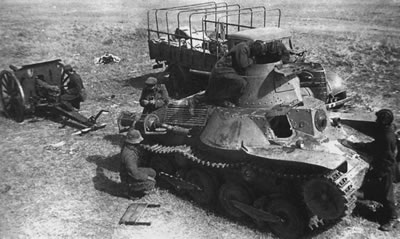The Battle of Khalkhin Gol, between the Soviet Union and Japan, was one of the earliest World War II battles. It played a significant role in determining the course of the war.
In 1938, Japan and the Soviet Union disputed the position of the border between Siberia and Manchukuo, a puppet state in Manchuria that had been created by Japan.
Fighting first broke out between the two countries during the Battle of Lake Khasan, also known as the Changkufeng Incident, which took place between July and August 1938. The Soviets were victorious and pushed the Japanese from the disputed territory.
 In May 1939, Japan and the USSR again began fighting over the Soviet-Manchukuo border. The Japanese said the border ran along the Khalkhin Gol River (or Khalkha River), while the Soviets claimed that the border was near the village of Nomonhan.
In May 1939, Japan and the USSR again began fighting over the Soviet-Manchukuo border. The Japanese said the border ran along the Khalkhin Gol River (or Khalkha River), while the Soviets claimed that the border was near the village of Nomonhan.
At first, the fighting consisted only of some small skirmishes.
However, in June 1939, the Japanese began a more aggressive operation to regain territory. This operation, which included the deployment of two regiments with about 130 light tanks in total, led to what has become known as the Battle of Khalkhin Gol (sometimes spelled Khalkhyn Gol) or the Battle of Nomonhan.
Some of the Japanese forces were able to cross the Khalkhin Gol River and advance into Soviet-held territory.
However, the Russians launched a counterattack with more than 400 tanks and armored cars. After several days, the Soviets were able to destroy most of the Japanese tanks, which were no match for Soviet tanks. Japanese forces were pushed back.
Some more skirmishes took place and Japan tried another offensive attack. They still could not get past the Russians.
The Soviets then launched their own offensive strike, utilizing nearly 500 tanks as well as 250 aircraft and large cavalry, infantry and artillery forces.
The Soviets were able to surround the Japanese. The Japanese refused to surrender, so the Russians bombarded them with artillery and attacked them by air. By August 31, all of the Japanese forces had been destroyed.
On September 15, a peace treaty was signed between the Soviet Union and Japan.
After their defeat at Khalkhin Gol, the Japanese were wary of fighting the Soviets again, so they decided to focus their attention on conquering Southeast Asia.
Meanwhile, the Soviets were now free to focus on invading Poland.
The Nazi invasion of Poland had begun on September 1.